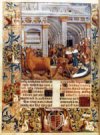ORIGINALLY
T he Basilica
Saint SERNIN of Toulouse finds her origin in the wish to honour the memory of
SATURNIN, first bishop and martyr of Toulouse which lived in the first half of
the III° C. The Latin name " Saturnius", was transformed in the
Oc language into " Sarni " then francized into " Sernin ".
In 250, having refused to yield
to the obligation which was made to all the citizens by the Roman emperor Dèce,
to sacrifice to paganism's gods, Saturnin was attached by the feet to a bull which
must be immolated and was trailed through the streets of the city until dead follows.
Its body was collected and buried in a wood casket.
During the IV° C., the Hilaire bishop made
erect above the place of the casket a small wood basilica to honour the memory
of his predecessor. The exact site of this tomb is unknown. The Toulouse tradition
wants that the Gothic church of the TAUR perpetuated the memory of it but the
excavations did not reveal anything of conclusive on that score.
In front of the importance of the devotion
and the development of the necropolis caused by the glory and the virtues of
the martyr, the Silve bishop undertook towards the end of the IV° C. the
construction of a new basilica - martyrium. This monument was completed under
its Exupère successor who transferred the remainders to it from Saturnin
by burying them in a marble sarcophagus in November of the one of the first
years of V° C. In 844, a community of canons had been founded to take care
on the body of the saint and to ensure the liturgical
celebrations. In second half of the XI° C., the chapter of the canons of
Saint - Sernin was with the head of a considerable land inheritance, which enabled
him to replace the antique basilica by the current monument.
Saint-Sernin had become a major stage on the road of the pilgrimage
of Saint - Jacques de Compostelle and the old church was not enough any
more to accomodate crowd which presented
itself. Between 1070 and 1080
one started to raise the Eastern part of the new church. In 1096 the déambulatoire
and its vaults, the chorus and its roundabout, the transept and its vaults were
almost finished. The chapter could then launch out in the construction of the
1080
one started to raise the Eastern part of the new church. In 1096 the déambulatoire
and its vaults, the chorus and its roundabout, the transept and its vaults were
almost finished. The chapter could then launch out in the construction of the second part of the building which includes the nave and its collateral as well
as the Western frontage with its two turns. Then work trailed in length with
modifications of structure until the XIV° c. et even with the XVI° C.
for certain elements. The Western towers were never completed.
second part of the building which includes the nave and its collateral as well
as the Western frontage with its two turns. Then work trailed in length with
modifications of structure until the XIV° c. et even with the XVI° C.
for certain elements. The Western towers were never completed.
From XVI° C. to our days, additions and
restorations (by Viollet-le-Duc in 1855) deteriorated this monument - key of
Romance art. The basilica Saint- SERNIN of Toulouse is most famous, vastest
and most beautiful of the Romance churches of the South, richest of France in
relics.
Top of Page
 second part of the building which includes the nave and its collateral as well
as the Western frontage with its two turns. Then work trailed in length with
modifications of structure until the XIV° c. et even with the XVI° C.
for certain elements. The Western towers were never completed.
second part of the building which includes the nave and its collateral as well
as the Western frontage with its two turns. Then work trailed in length with
modifications of structure until the XIV° c. et even with the XVI° C.
for certain elements. The Western towers were never completed.